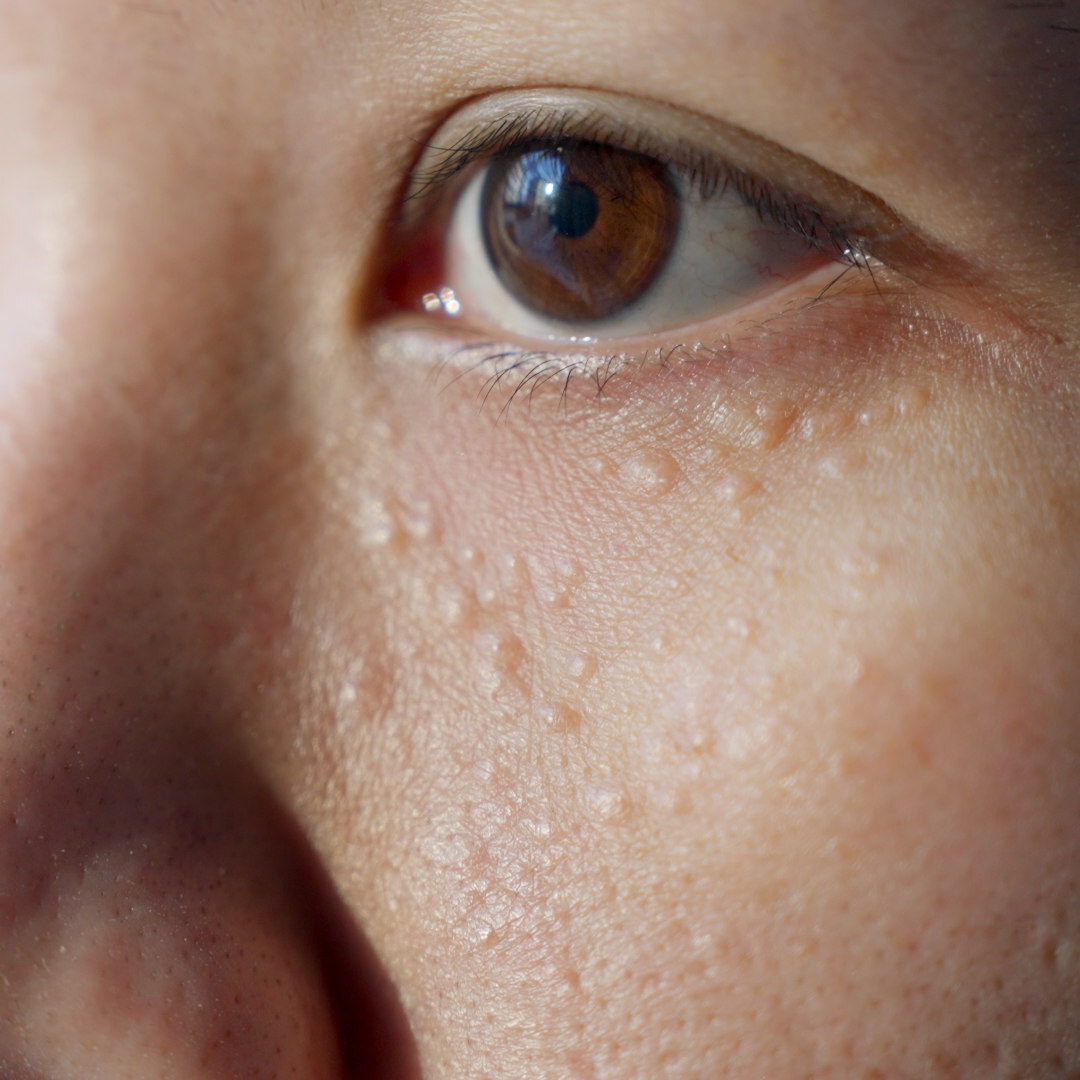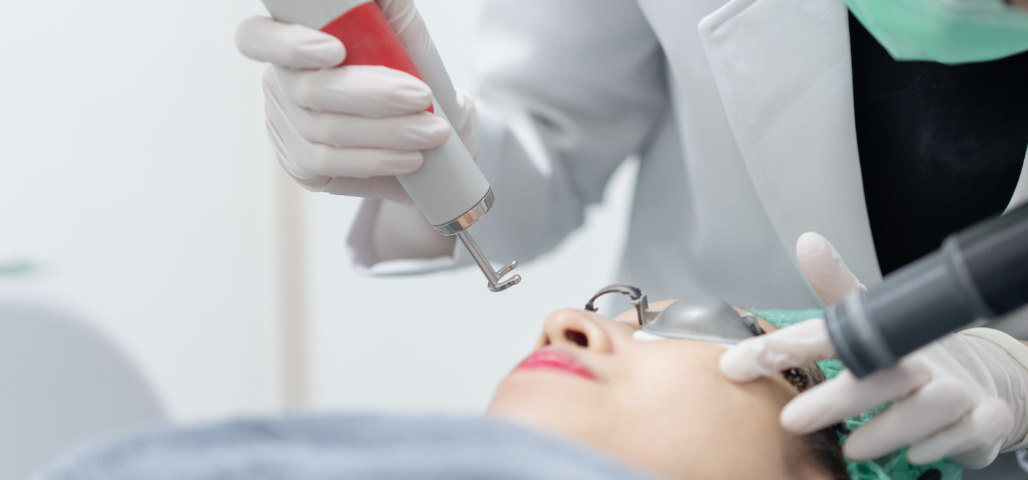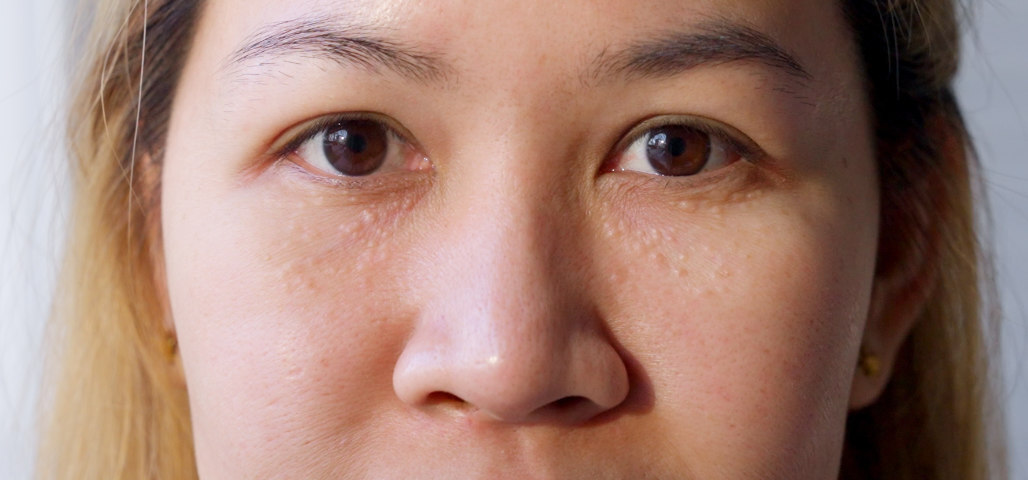Spotlight on Syringoma
Causes, Diagnosis, Treatment Options, and Cosmetic Concerns

Our expert team can help you achieve smoother, clearer skin with minimal downtime.
Syringoma can sometimes be mistaken for Xanthelasma (cholesterol deposits on the eyelids). In addition to Syringomas, other conditions that may cause skin abnormalities around the eyelids include Milia, eyelid skin tags, and Sebaceous Hyperplasia.
What Is It?
Syringoma is a harmless skin condition that shows up as small, firm, flesh-coloured or yellowish bumps, usually around the eyes. These bumps are non-cancerous growths of the sweat ducts, which help produce sweat. While syringomas don’t cause any health problems, they can be a cosmetic concern because they often appear in clusters, making the skin look uneven or bumpy.
What Causes It?
Syringomas form when cells in the sweat glands grow too much. The exact reason isn’t fully known, but some factors have been linked to this condition.
Genetics may play a part since syringomas run in families. Certain conditions, like Down syndrome, also make people more likely to get syringomas. They can appear during or after puberty, but sometimes show up later in life.
Other factors include hormone changes, especially during teenage years or pregnancy, which might trigger syringomas. The condition is more common in women than men, but both can be affected. People with diabetes, particularly a type called eruptive syringoma, may also develop them.

Symptoms and Types
The main sign of syringoma is the appearance of small, firm bumps called papules. These are usually 1 to 3 millimetres wide and are skin-coloured or yellowish. While most often found around the eyelids and upper cheeks, syringomas can also show up on the neck, chest, armpits, and stomach.
Syringomas are grouped into different types based on how they appear and their connection to other health conditions. These include:
- Localised Syringomas: The most common type, usually found on the face, especially around the eyes.
- Eruptive Syringomas: These are multiple papules that show up quickly, often on the chest, stomach, and neck.
- Familial Syringomas: This type runs in families, indicating a possible genetic cause.
- Syringoma Linked to Down Syndrome: People with Down syndrome are more likely to develop syringomas.
Diagnosis
Syringomas are usually diagnosed by their typical appearance. Dermatologists often do a physical check of the bumps to confirm the diagnosis. Sometimes, a biopsy is done to rule out other skin issues. A biopsy involves taking a small sample of the bump and looking at it under a microscope to make sure it’s non-cancerous and comes from the sweat ducts.
Treatment Options
Although syringomas are harmless and don’t need medical treatment, many people choose to remove them for cosmetic reasons. Treatment options aim to reduce their appearance.
At MJExposé Health & Beauty, we carefully evaluate each case to ensure the safe and effective removal of syringomas. Using advanced laser technology, we focus on eliminating syringomas while minimising the risk of scarring. Depending on the size and depth of the bumps, most treatments require 3 to 6 sessions for complete removal.
Common treatments include:
- Laser Therapy: A popular option is carbon dioxide (CO2) laser therapy. The laser breaks down the growths while protecting nearby skin. It’s usually safe with little recovery time, but multiple sessions might be needed.
- Electrosurgery and Cauterisation: This method uses electricity to burn off syringomas. It’s effective, but may cause some scarring or skin colour changes.
- Cryotherapy: Cryotherapy involves freezing syringomas with liquid nitrogen. It’s less common but works for smaller bumps. There’s a risk of skin colour loss (hypopigmentation) or light scarring.
- Surgical Excision: For larger or more stubborn syringomas, surgery may be needed. This involves cutting out the bumps and is used when other treatments don’t work. It has a higher chance of scarring and a longer recovery time.
- Topical Treatments: Dermatologists may prescribe creams or ointments, like retinoids or acids, to shrink and reduce syringomas. These treatments often take longer to show results and are used with other methods.

Future Outlook and Risk of Return
The outlook for syringoma is generally good since it’s a harmless condition with no health risks. However, one of the main challenges in treating syringomas is that they can come back. Even after successful removal, the bumps may return, especially if the treatment didn’t fully remove the underlying cells. Recurrence is quite common with treatments like laser therapy and electrosurgery, though they are still the preferred options as they are less invasive.
Syringomas can’t be prevented, and those with a genetic tendency may continue to develop new bumps throughout their lives. Regular check-ups with a dermatologist are advised for those prone to recurrence, especially if cosmetic concerns remain.
Living with Syringoma
Although syringomas are harmless, they can still affect how people feel, especially when they appear on visible areas like the face. Some may feel self-conscious about their looks, especially if the bumps become more noticeable over time. Treatment can help with these concerns, but it’s important to have realistic expectations, as full removal isn’t always possible.
For those who choose not to get treatment, it’s reassuring to know that syringomas don’t impact overall health. Some people use makeup or cosmetic products to cover the bumps, though care should be taken to avoid further irritating the skin.
Conclusion
Syringomas are harmless tumours linked to sweat glands, but they can cause cosmetic worries for those affected. Treatments like laser therapy, electrosurgery, and cryotherapy are available, though the bumps often come back. Diagnosing syringomas is usually simple, with dermatologists able to confirm it through an exam or biopsy. While syringomas can’t be prevented, they don’t pose any health risks, and treatment is usually done for cosmetic reasons.
Managing syringomas means understanding that they are harmless and that full removal may not always be possible. Whether choosing treatment or deciding to live with the condition, it’s important to make informed choices based on personal preferences and advice from a dermatologist.
Schedule your appointment now and take the first step towards feeling confident in your appearance!
Let our expert team help Let our expert team help

 AfterPay is avaliable for all purchases.
AfterPay is avaliable for all purchases.